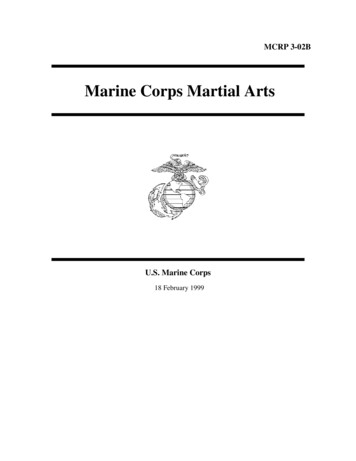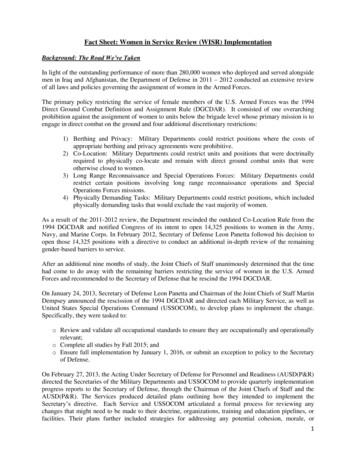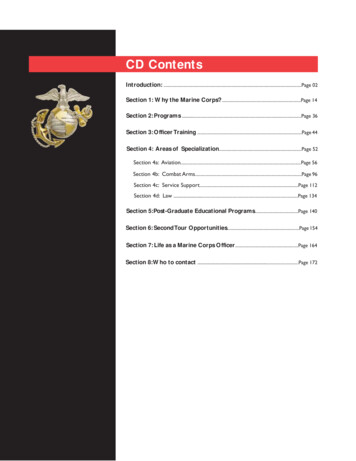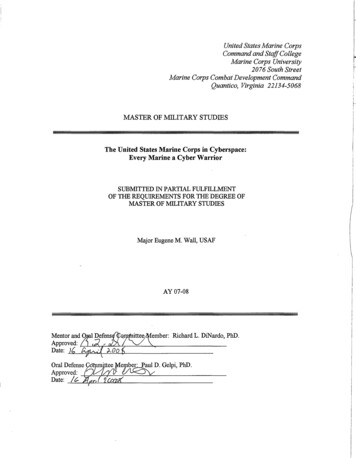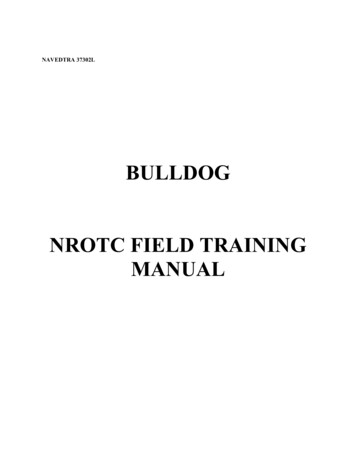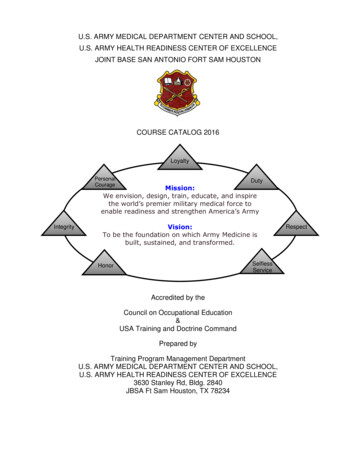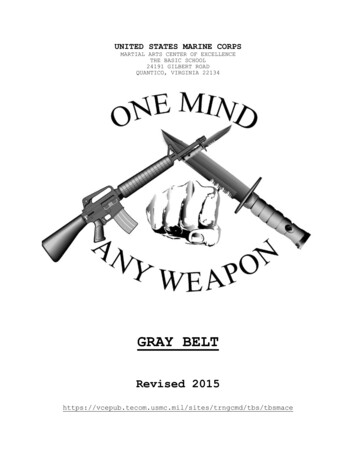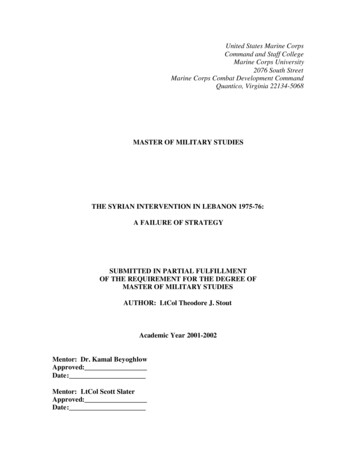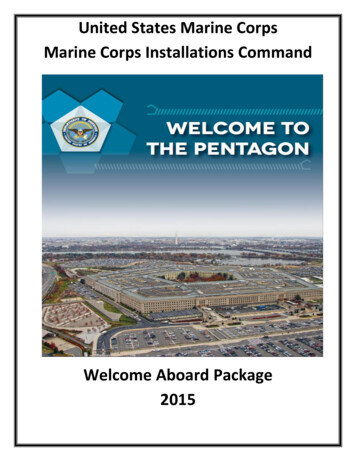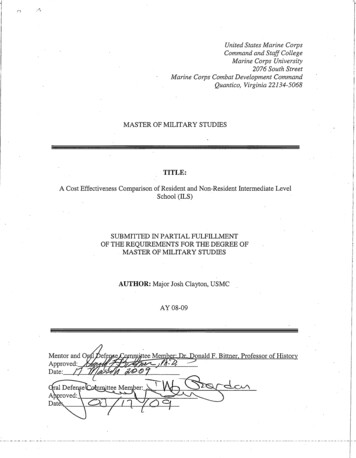
Transcription
1United States Marine CorpsCommand and Staff CollegeMarine Corps University2076 South StreetMarine Corps Combat Development CommandQuantico, Virginia 22134-5068MASTER OF MILITARY STUDIESTITLE:A Cost Effectiveness Comparison of Resident and Non-Resident Intermediate LevelSchool (ILS)SUBMITTED INPARTIAL FULFILLMENTOF THE REQUIREMENTS FOR THE DEGREE OFMASTER OF MILITARY STUDIESAUTHOR: Major Josh Clayton, USMCAY 08-09Mentor andd O [: Onga l,Q.dlF . B1!itgtn e:LrJP rQo ge s§Jso2!r orrflHiji]!st o[yrApproved:--::Date: LJ-'--JIZt. L 'L
Form ApprovedOMB No. 0704-0188Report Documentation PagePublic reporting burden for the collection of information is estimated to average 1 hour per response, including the time for reviewing instructions, searching existing data sources, gathering andmaintaining the data needed, and completing and reviewing the collection of information. Send comments regarding this burden estimate or any other aspect of this collection of information,including suggestions for reducing this burden, to Washington Headquarters Services, Directorate for Information Operations and Reports, 1215 Jefferson Davis Highway, Suite 1204, ArlingtonVA 22202-4302. Respondents should be aware that notwithstanding any other provision of law, no person shall be subject to a penalty for failing to comply with a collection of information if itdoes not display a currently valid OMB control number.1. REPORT DATE3. DATES COVERED2. REPORT TYPE200900-00-2009 to 00-00-20094. TITLE AND SUBTITLE5a. CONTRACT NUMBERA Cost Effectiveness Comparison of Resident and Non-ResidentIntermediate Level School (ILS)5b. GRANT NUMBER5c. PROGRAM ELEMENT NUMBER6. AUTHOR(S)5d. PROJECT NUMBER5e. TASK NUMBER5f. WORK UNIT NUMBER7. PERFORMING ORGANIZATION NAME(S) AND ADDRESS(ES)United States Marine Corps,Command and Staff College, Marine CorpsCombat Dev,Marine Corps University, 2076 SouthStreet,Quantico,VA,22134-50689. SPONSORING/MONITORING AGENCY NAME(S) AND ADDRESS(ES)8. PERFORMING ORGANIZATIONREPORT NUMBER10. SPONSOR/MONITOR’S ACRONYM(S)11. SPONSOR/MONITOR’S REPORTNUMBER(S)12. DISTRIBUTION/AVAILABILITY STATEMENTApproved for public release; distribution unlimited13. SUPPLEMENTARY NOTES14. ABSTRACT15. SUBJECT TERMS16. SECURITY CLASSIFICATION OF:a. REPORTb. ABSTRACTc. THIS PAGEunclassifiedunclassifiedunclassified17. LIMITATION OFABSTRACT18. NUMBEROF PAGESSame asReport (SAR)3519a. NAME OFRESPONSIBLE PERSONStandard Form 298 (Rev. 8-98)Prescribed by ANSI Std Z39-18
J('''.rEXECUTIVE SUMMARYTitle: A Cost Effectiveness Comparison of Resident and Non-Resident Intermediate LevelSchool (ILS).Author: Major Josh Clayton, United States Marine CorpsThesis: In the ever changing and developing combat environment that exists for Marine leaders,the process of evaluating and refining the educational experience must be continuous.Discussion: Improving Marine officers Professional Military Education (PME) is criticallyimportant for the continued excellence of the officer corps. The challenge for the Marine Corpsis to find the conect balance between providing an applicable education for cunent and futureleaders while meeting operational requirements in a wartime environment. Educating ourleaders is vitally important for the continued advancement of excellence in the Marine Corps, s meeting this challenge should be a priority.This paper will compare the costs and perceived effectiveness of both Resident and Non- 'Resident Command and Staff College educations. It will further compare the cost effectivenessof both programs and discuss alternate systems for providing the required education. Withrespect to costs, time is the cost directly examined. Not the cost in time to the individual Marine,but the time that the Marine Corps is paying to ensure that a Marine receives his/her education.Because this is a time cost to the Marine Corps, it can be associated with a dollar cost to theMarine Corps for that time. There is no cost in time for the Non-Resident Command and Staffeducation. Therefore dollar costs are used for the comparison. The effectiveness of aneducational experience will vary greatly with the individual students. Therefore the perceptionof effectiveness as perceived by past studies and surveys, as well as promotion rates forgraduates were used for the comparison.Conclusion: Dedicated time for study, be it Resident or Non-Resident, is the most influentialfactor regarding the effectiveness of the educational experience with regard to intermediate levelschool. Because of the dedicated time allotted to Resident ILS, the per student costs are muchhigher than those of the Non-Resident. The effectiveness of Resident ILS has been determinedto be higher, but not enough to offset the significantly higher costs. Therefore when comparingthe two programs, Non-Resident ILS is much more cost effective than Resident ILS.i
DISCLAIMERTHE OPINIONS AND CONCLUSIONS EXPRESSED HEREIN ARE THOSE OF THEINDIVIDUAL STUDENT AUTHOR AND DO NOT NECESSARILY REPRESENT THEVIEWS OF EITHER THE MARINE CORPS COMMAND AND STAFF COLLEGE OR ANYOTHER GOVERNMENTAL AGENCY. REFERENCES TO THIS STUDY SHOULDINCLUDE THE FOREGOING STATEMENT.QUOTATION FROM, ABSTRACTION FROM, OR REPRODUCTION OF ALL OR ANYPART OF THIS DOCUMENT IS PERMITTED PROVIDED PROPERACKNOWLEDGEMENT IS MADE.
--j,\"Table of Contents'PagePREFACEiiINTRODUCTION/HISTORy1PER STUDENT COST COMPARISON3EFFECTIVENESS COMPARISON10COST EFFECTIVENESS COMPARISON15ISSUES FOR CONSIDERATION16ALTERNATIVE BIBLIOGRAPHY25APPENDIX A: LIST OF ACRONYMS28APPENDIX B: SURVEY QUESTIONS29
PrefaceThis paper has been undertaken due to a personal interest in Command and Staff Colleg;elevel of Professional Military Education (PME). I had completed approximately three-quartersof the Non-Resident course when I was told thatI'd been selected to attend the Resident Courseof the 2008-2009 academic year. After several months in attendance, I felt the Resident Courseexperience had been good for me personally, but not necessarily for the Marine Corps. Thebenefits presented throughout the course continually placed the professional benefits to theMarine Corps secondary to those of the individual Marines. In Marine Corps aviation, theperceived benefits of attending Resident PME are primarily personal. The professional benefitsassociated with attendance are offset by the loss of proficiency due to reduced operationalexperience.I began to think that there had to be a more efficient program that could capture thepersonal and professional benefits of the Resident course while, at the same time, reduce thedollar cost associated with the current program. I have determined to examine the costeffectiveness of both programs to propose a more efficient educational program that will capturethe benefits of the current Resident program while reducing dollar costs over time; I shall thenmake recommendations for expanding those benefits to the individual officers of the NonResidency course.An area for further development that is not addressed in the paper are the dollar costsassociated with the facility and curriculum development of both the Resident and Non-ResidentCourses.I would like to extend my appreciation to several individuals for their support and advicewith the following acknowledgements:11
IIDr. Donald Bittner, Professor of Military History, Marine Corps Command and StaffCollege, for his mentorship and support while undertaking this project.Dr. John Gordon, Professor of National Security Affairs, Marine Corps Command andStaff College, for his mentorship and support throughout the CSC program.Lieutenant Colonel Bjomar Lunde, NOR Army, Faculty Advisor, Marine CorpsCommand and Staff College, for his leadership and guidance throughout the CSC program.Ms. Linda Rohler, Registrar, Marine Corps Command and Staff College, for herassistance with obtaining background material and student information critical to thedevelopment of the paper.My wife, Melissa, and our two sons, Ray and Adam, for their understanding and supportthroughout all my endeavors while in the Marine Corps.
Improving Marine officers Professional Military Education (PME) is criticallyimportant for the continued excellence of the officer corps. The challenge for the MarineCorps is to find the COlTect balance between providing an applicable education for CUlTentand future leaders while meeting operational requirements in a wartime environment.Educating our leaders is vitally important for the continued advancement of professionalexcellence, so meeting this challenge should be a priority. This paper will compare thefinancial costs per student and perceived effectiveness of both Resident and NonResident Command and Staff College educations. It will further compare the costeffectiveness of both programs and discuss alternate systems for providing the requirededucation. In the ever changing and developing combat environment that exists forMarine leaders, the process of evaluating and refining the educational experience must becontinuous. All four services have resident and non-resident equivalents. Each of theresidency courses is approximately ten months in length and only a small percentage ofofficers are able to attend the full length resident intermediate level courses. CUlTently,only the Navy and Air Force also offer the option to acquire a Masters Degree throughtheir non-residency programs.HISTORYThe beginnings of resident Marine Corps officer Professional Military Educationcan be traced back to the establishment of the School of Application in 1891. This schoolbecame the Marine Officers School in 1908 and in 1919 the Marine Officers TrainingSchool. By 1920, under the guidance of Colonel John C. Beaumont, this school would berenamed The Basic School (TBS). He further designed a three-tiered system of educationwith the development of the Field Officers Course in October 1920 and the Company1
--!Officers Course in July 1921. 1 These three courses formed the foundation for whatGeneral Lejeune termed "Marine Corps Schools". In the mid 1920s, conespondencecourses were established to parallel the Field Officers and Company Officers residentcourses to expand the audience of the Marine Corps Schools. During the development ofthe M rine Corps amphibious doctrine of the 1930's, two of the schools wereredesignated Amphibious Warfare Senior and Junior Courses for Field Grade andCompany Grade officers. These closed in 1941, but "in 1943, an operationally oriented. three month Command and Staff Course, later renamed the Command and Staff School,opened at Quantico based on the need for school-trained, field grade officers withcommensurate skills to serve in the Pacific Theater."z In 1946, the Marine Corpsprofessional military education system was again organized into the three-tiered system.In 1964, the Senior School was re-designated Command and Staff College (CSC) and theJunior School became Amphibious Warfare School (AWS). In 1989, Marine CorpsUniversity was created and in 1990, the School of Advanced Warfighting (SAW) and theMarine Corps ·War College (MCWAR) were established. In 1997, the College ofContinuing Education (CCE) was created and directed to integrate all officer distanceeducation programs within a single college. 3 In 2004, AWS was renamed ExpeditionaryWarfare School (EWS). As of February 2009, Training and Education Command(TECOM) organized Officer Candidate School and TBS under the Training Command(TRNGCOM) division while EWS, CSC, SAW, and MCWAR fall under the EducationCommand (EDCOM)/Marine Corps University (MCU). CCE belongs directly toTECOM.2
The Marine Corps CSC is a part of MCV and is staffed with civilian and militaryfaculty for course development, instruction, and administration. Classes generally consistof approximately 200 students of which approximately half are Marines. The other halfof the students are sister service personnel, civilian agency personnel, and internationalofficers. The current curriculum is divided into four sections that include:Warfighting.from the Sea (WFTS), Culture and Interagency Operations (CIAO),. Operational Art (Op-Art), and Leadership.4 The students are divided into twelveconference groups (CG) of approximately sixteen students each that are led by onecivilian and one military faculty advisor per CG.The Marine Corps non-resident ILS program is the Command and Staff CollegeDistance Education Program (CSCDEP) under CCE. It completes the ILS requirementfor approximately 80% of Marine Officers and the curriculum is developed from the CSCcurriculum and is divided into eight courses that include: Theory and Nature of War,National and Iritemational Security Studies, Operational Art, Joint Warfighting, SmallWars, MAGTF Expeditionary Operations, Amphibious Warfare, and OperationalPlanning. CSCDEP is taught through seminars conducted online or in person by theiradjunctfaculty whom conduct weekly two to three hour seminars. The adjunct facultymembers are organized into classes with approximately twelve students per class by eightregional coordinators throughout the U.S. and Okinawa, Japan. 5PER STUDENT COST COMPARISONDetermining the costs of any institutional education is a multi-dimensional issue.There are finite dollar costs for each academic year that are based on facilities, staff, and.materials. With respect to CSC, the variables are increased significantly because not only3
are there the previously mentioned costs, but also those costs directly attributed to thestudents. The true student cost is their time for the education, but associated with thattime there are student pay variables. There are also less tangible human costs to beconsidered that include allocation of personnel, recruitment, and retention. Furthermore,the costs associated with resident and non-resident CSC are not mutually exclusive.Because the CSCDEP curriculum is molded from the resident curriculum, not all costscan be separated. Therefore, facility and curriculum development costs for both esc andCSCDEP will not be included in this comparison. The civilian and military staffs thathave curriculum developmental roles will also not be considered. Determining the actualdollar cost of either resident or non-resident CSC is beyond the scope of this paper;therefo e,only the dollar costs not related to facilities or curriculum development will beused for comparison. CSCDEP material costs will be included in that program's totalcost under the assumption that it is material used in addition to the CSC coursecurriculum.Determining the dollar cost not associated with facilities or curriculumdevelopment for resident CSC will include individual student pay, permanent change ofst3;tion (PCS) requirements, and military faculty advisors not in a curriculumdevelopment billet. Individual pay factors would include rank, time in service,dependants, incentive pay, and bonuses. For this reason, the resident cost determinationwill be based on a Major with over twelve years of time in service. This Major will havea dependent, live off base, and have no incentive pays or bonus. This "average USMCstudent" determination is based on the authors interactions with his classmates for AY'08-'09 in which he is a junior Major in the class with only eleven years in service, is not4
aware of any USMC students without at least one dependent, and only knows of oneUSMC student who lives on base housing. The class does have 29 aviators in it, but theiraviation career incentive pays and bonuses will not be considered due to multiplevariations. 6 This average student estimate will generally give a lower end estimate, butwill suffice for the comparative purposes of this paper. The school length is just over 10months, so 10 months of pay and allowances will be used to determine student cost. Thisdoes not include any time or costs associated with relocation either before or after theacademic year since travel allowances are included in the pes cost estimation.Additional time often associated with a pes has also been excluded since it is designatedleave time that every service member has available for use at hislher discretion. The pesrequirement will be an assumption that attending the course will require one additionalpes move for 60% of USMe students. This is based on the estimate that only 20% ofesc residents were previously stationed locally and 20% of ese students will remainlocally upon graduation. These percentages are based solely on estimates by the author.The academic year is fully inclusive of August through May. The five months of.pay and allowances in 2008 will cost 42,249.80 and the five months in 2009 will cost 43,112.70 ( 6,088.2 Base pay? 202.76 BAS 2,159 BAH for 5 months in '08 plus 6,325.5 Base payS 223.04 BAS 2,074 BAH for 5 onths in '09). As previouslymentioned, no incentive pays or bonuses will be added, although the AY 08-09 classcontains 29 aviators, many of whom are receiving a 650 per month aviation careerincentive pay and annual bonuses ranging from 7,000 to 20,000. Total pay andallowances for this average student would be 85,362.50.5
1I'.BAH/monthBAS /monthTotal AYPayStudent Pay '08Base Pay/month 6,088.2 2,159 202.76 42,249.80Student Pay '09 6,325.5 2,074 223.04 43,112.70Total '08- '09Student Pay 85,362.50Table I - Average Student Pay and Allowances EstimationPCS costs will vary greatly depending on number of dependants, movementweight, and distance of the move. The total cost for USMC PCS moves for FY 09 isexpected to be 473,952,000. With 29,072 expected movers, that averages out to 16,302.70 per PCS according to the Department of the Navy FY '09 Budget Estimate. 9This average cost will be used for the analysis although the true cost will likely be higherfor most 0-4' s. If 60% of the USMC portion of the class is expected to require oneadditional move, then to filter this cost to a student average cost it will be 9,781.62 perstudent.PCS CostsPer mover% extra moves 16,302.70.6Total(averaged/student) 9,781.62Table II - PCS Costs Averaged per StudentThere are eleven active duty USMC faculty members, and for inclusion of mlliualcost, only eight will be included based on their title as simply "faculty advisors."l0 Theothers are assumed to playa role in curriculum development along with the civilianfaculty. These eight are all Lieutenant Colonel's (LtCol), and an assumption must bemade about their pay, time in service, allowances, and bonuses. For purposes ofsimplicity, they will all have dependents, be over 14 years of service, and receive nobonuses. The basis for this "average" faculty member is simply that the most junior6---,---
LtCol will have at least 15 years of service. This equates to 45,535.8 in '08 plus 46,269.2 in '09 or 91,805 each ( 6,596.40 Base payll 202.76 BAS 2,308 BAHfor 5 months in '08 plus 6,853.8 Base pay12 223.04 BAS 2,177 BAH for 5 monthsin '09). This again is a low end estimate simply due to the fact that two of the eight areaviators that are likely receiving aviation career incentive pay and bonuses. The cost ofthe eight faculty advisors is 734,440. If this cost is split amongst the 93 USMC studentsequates to 7,897.20 per student.BAH/monthBAS /monthTotal AY PayFaculty Pay 08Base Pay/month 6,596.40 2,308 202.76 45,535.8Faculty Pay 09 6,853.8 2,177 223.04 46)69.2Total 08-09AYPayX8USMCfaculty 91,805 perFaculty AdvisorPer student cost 734,440Divided by 93 7,897.20studentsTable III - Per Student Costs for USMC Faculty AdvisorsThe total dollar costs not associated with the facility or curriculumdevelopment for the resident CSC student for purposes of this analysis is 103,041.32( 85,362.50 9,781.62 7,897.20).StudentPay/Allowances 85,362.50PCS CostsAveraged/Student 9,781.62Per Student Cost ofUSMC Faculty 7,897.20Total CSC perStudent Cost 103,041.32Table IV - Total CSC per "Average" Student CostFor the CSCDEP program, cost determination excluding curriculum development·is much less complicated. All student pay costs will not be factored since these officersare performing their regular duties in conjunction with completing the course. Someestimates and assumptions must still be made in order to determine the per student cost.7
--1-The cost for each adjunct faculty/seminar leader is 7,300 per year. 13 The optim mseminar size is twelve students meeting for two to three hours weekly for an averagecourse length of two years. This will result in a 608.33 cost per student per year. Thereare cunently 1,444 USMC students enrolled in CSCDEP with 90 instructors teaching 121total seminars. 14 Some class participation will be larger and some smaller, but forpurposes of this analysis, the optimum size will be used for determining per student cost.Similarly, variations will occur with course length depending on each student and theirindividual circumstances. Again, the average course length will be used. This equates to 1,216.66 for the course. Finally, the material cost is 312 per student. 15 Material costsfor the CSCDEP student have been included under the assumption that the material isadditional to the developed curriculum. This brings the total cost for the CSCDEP to 1,528.33 per student for purposes of this analysis vyhen excluding facility andcuniculum development costs.Adjunct Faculty Per Student (12Pay/Yearper)/Year 7,300 608.33Per Student X 2Year Course 1,216.66Material Cost(Per Student) 312Total CSCDEPCost/Student 1,528.33Table V - Total CSCDEP Cost per StudentAn important issue to discuss is the costs not considered in this analysis. Civilianfaculty, base support, and building operation and maintenance costs are not included inthe CSC costs. However, it is important to note that total MCU appropriated funding forFY08 is 62,955,866. CSC has 35 faculty members of the 312 MCU faculty and staffmembers (11.2%). If this CSC faculty ratio is applied to the appropriated funding, itamounts to over 7.06 million dollars. If this total is divided by the number of USMCstudents (93), the per student total is 75,939.32. However, there are an additional 608
lIUSMC Majors receiving intermediate education with sister service, international, andfellowship ILS programs. Therefore, they should be factored in to the total number ofstudents receiving ILS educations at this cost. That would then give a cost of 46,159(7.06 mil /153) per USMC student receiving an ILS resident education. Of note, themilitary pay of faculty that is included in the comparison is a portion of the appropriatedfunding information. Also not included in CSCDEP total, due to being consideredfacility and curriculum development costs, are eight CSCDEP Course Directors whodevelop, revise, and update the CSC cUlTiculum, and a Government Assistant Dean thatmanages the CSCDEP. There is also the cost to run eight regional campuses world-wideand the management/administrative costs for the essential functions accomplished by theCCE staff. Again, this additional cost has not been included in the cost comparison, butthey are significant ones worth noting.When examining the costs previously covered, the fact that time is the real costbecomes evident. All students and faculty would be getting the same pay regardless oftheir location, but since CSCDEP students are filling other billets requiring Marines, thedollar costs associated with that time is not applied. The resident CSC student cost is at .least 10 months. All dollar amounts are simply fiscal costs associated with that time.Time is a human cost, with dollar costs associated. The other associated human costsrelating to time will vary greatly amongst students based on both their personal andprofessional situations. Therefore, the dollar costs previously discussed will be the solecosts referenced for the cost effectiveness comparison to follow.9
EFFECTIVENESS COMPARISONDetermining the effectiveness of the any educational experience presents a greatchallenge. There are many factors that contribute to the effectiveness of anins itution toinclude its curriculum, faculty, learning environment, delivery methods, and numerousindividual student criteria. Some of the student criteria include initial knowledge base,receptiveness, and distractions. Ultimately, the learning effectiveness is"the growth inknowledge and skills of the student at th,e conclusion of the experience. This will varygreatly amongst students which therefore complicates the determination of effectiveness.In order to truly determine the effectiveness of a program, it must be evaluated against itsgoals or mission. The mission statement of both esc and CSCDEP: "Informed by thestudy of history, language and culture, CSC educates and trains its joint, multinational,and interagency professionals in order to produce skilled warfighting leaders able toovercome diverse 21st Century security challenges.,,16There is no evaluation at the beginning or conclusion of either CSC or CSCDEPthat would allow for a true effectiveness evaluation to occur. The intent of both coursesis to ensure its graduates have reached a baseline knowledge and skill-set that includesthe listed goals. Due to this limitation, an outcome observation comparison will be madeof the two programs based on prior research of opinion surveys and promotion rates fromMajor to LtCol.The 2001 study of Marine Corps PME programs conducted by the Studies andAnalysis Division of the Marine Corps Combat Development Command (MCCDC)hypothesized that resident PME graduates would provide a greater value to the MarineCorps than their non-resident peers. Contrary to this hypothesis, their opinion survey10------------- - - - - - - -
results found little difference between the two. "The only performance category whereresident graduates clearly stood out was in staff skills.,,17In 2002 Major John Makillooked at the equivalency of resident and nomesidentILS in the Marine Corps. His paper focused on why Majors who had completednonresident ILS had also decided to attend esc. This survey results had similar resultsto those of the S&A survey in that the top reason for attending was peer-networkingfollowed by development of staff skills. The survey that he conducted asked about thebenefits of resident ILS and provided options to choose from. The top five benefits inorder were: networking with peers, MAGTF officer skills, preparation for staff jobs,advanced degree, and follow on assignments. 18 The paper also asked hystudents attendresident ILS after having completed non-resident ILS. The only options available werebenefits previously mentioned. Despite this, several responders made additionalcomments later in the survey that indicated they did not want to attend. 19 The evidenceprovided by the paper indicated that there was a professional perception that resident ILSwas more career enhancing than non-resident ILS.A 2003 master's thesis by Major Raul Lianez and Major Luis Zamarripa from the.Naval Postgraduate School conducted a Comparative analysis of resident PME and acivilian graduate' education. In their analysis, they evaluated the fitness reports ofgraduates before and after attending resident PME and compared them to performancetrends of officers with no graduate education (NOS). Non-resident PME graduates madeup the majority of the NOS subjects. Their findings indicated that attending PMEgraduate education resulted in an 'after' performance that was no different from the mean'"fter' performance of a NOS officer. "Thus, we can infer that the subsequent11I ------'
Ieperformance of an officer who attends PME graduate education is likely not significantlydifferent from that of an officer who does not attend."zo This fitness report analysis doesnot necessarily determine effectiveness of the education, but an officer's knowledge andthought process as developed in their educational experience are contributing factors intheir overall performance. Therefore, the analysis does give an indication that officer'sperformance improvements due to both resident and non-resident educations are similar.The pr motion rate of Marine Majors to LtCol is also not necessarily a measure ofeffectiveness, but is an indicator of the quality of the graduates. This quality of graduatesis a result of many individual factors, one of which is the knowledge and skills that theindividuals possess. Obviously influential to the kIiowledge and skills that a Marineofficer possesses is the educational experience that he/she has experienced. For thepurposes of this analysis, the FY08 LtCol selection board results and the CSC graduatingclass of 2004 and 2005 will be examined for promotion rates. The FY08 LtCol selectionboard results will be used because information regarding selected LtCol attendance toCSC has been determined in Major Joel Hoffman's 2008 Naval Postgraduate SchdolMaster's Thesis. The CSC classes of 2004 and 2005 will be used because all of thosegraduates would have been in zone for selection as of the most recent (FYlO) boardresults.The FY08 LtCol board results had 520 Majors in zone for promotion. Of those,338 were selected for promotion at arate of 65%. Of all 520 in zone, 461 of theseofficers had completed ILS or higher PME, of which 323 were selected (70.1 %) forpromotion. Of those 520 in zone, 152 had attended resident CSC. 116 of the 152 officersthat attended CSC were selected at a rate of 76.3%. "This was 11.3 percentage points12
II''0higher than the overall in-zone population election rate of 65.0 percent.,,21 To find thenon-resident ILS promotion rate, simply reduce the numbei' of resident ILS students fromthe total number of students who are ILS PME or higher complete gives a selection of207 of 309 eligible or 67.0%. Those not ILS complete selected at a rate of 25.4% (15 outof 59).Resident ILSCompleteNon-Resident ILS .CompleteNot ILS CompleteTotalIn Zone152Selected116% Selected76.3%30920767%1559520338Table VI - FY2008 SelectIOn ChartL1.1.25.4%65%When examining the CS
PROGRAM ELEMENT NUMBER 6. AUTHOR(S) 5d. PROJECT NUMBER 5e. TASK NUMBER 5f. WORK UNIT NUMBER 7. PERFORMING ORGANIZATION NAME(S) AND ADDRESS(ES) United States Marine Corps,Command and Staff College, Marine Corps Combat Dev,Marine Corps University, 2076 South . There is no cost intime for the Non-ResidentCommand and Staff education. Therefore .


